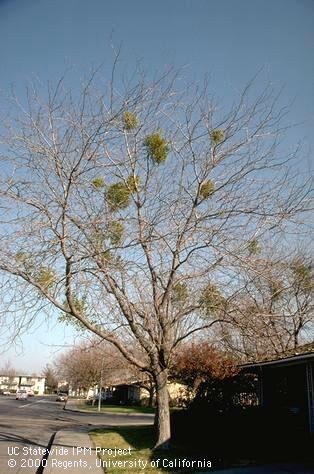Advice From the Help Desk of the Master Gardeners of Contra Costa County
MGCC Help Desk Response: I'm responding to your request to the MGCC Help Desk and provide some information about how you might try to eliminate or at least manage and reduce further spread of the mistletoe that has invaded your Japanese Maple.
As you know, mistletoe is a parasitic plant that lives on trees. Mistletoe is the common name given to several parasitic plants that grow on trees. It absorbs both water and nutrients from the tree. While an otherwise healthy tree can tolerate a couple of mistletoe infestations, trees that are stressed become even more stressed from the presence of mistletoe. Also, about 3 or 4 years after mistletoe starts growing on a tree, if the plant is a female, it can start producing sticky seeds which can fall and infect other branches or can be carried by birds to new locations. For these reasons, the University of California recommends that the problem be managed (http://www.ipm.ucdavis.edu/PMG/PESTNOTES/pn7437.html).
If it is possible to remove the branches or a portion of the branches where mistletoe is attached, that approach is the most likely to rid the tree of the infestation. If you use this approach, you will want to make your pruning cuts at least a foot below the location where the mistletoe is attached. The reason to make the cuts well below the attachment point is because the mistletoe creates rootlike structures in the water conducting tissue of the tree. These structures extend both up and down the branch. Removing the branch at least a foot below the point of attachment makes it more likely that you will remove the rootlike structures. If you fail to remove them, the mistletoe can regrow from the root structures. Before undertaking your pruning, you might also want to look at this University of California website which has a diagram depicting how the root like structures develop in the tree's tissue above and below the point of attachment of the mistletoe.http://www.ipm.ucdavis.edu/PMG/WEEDS/ID/mistletoechar.html
Also, as mistletoe can easily spread from tree to tree, you might want to encourage any neighbors with infected trees to take steps to eliminate infestations in their trees.
Finally, if you see that the tree is being stressed from the drought, giving the tree some additional water should help reduce the tree's stress. In addition to a deep watering approach, if you don't already have mulch around the base of the tree, you might want to add some. The mulch layer can help the soils retain water. Mulch 3-4 inches deep under the canopy of the tree. Avoid placing mulch immediately next to the trunk as it could harbor insect pests and diseases that may harm the tree.
We hope that this information is useful in your efforts to help your tree become and remain healthy. You're welcome to contact us again, either at a Farmers Market or through our Help Desk, if you have further questions.
Help Desk of the Master Gardeners of Contra Costa County
Note: The Master Gardeners of Contra Costa's Help Desk is available year-round to answer your gardening questions. Except for a few holidays, we're open every week, Monday through Thursday for walk-ins from 9:00 am to Noon at 75 Santa Barbara Road, 2d Floor, Pleasant Hill, CA 94523. We can also be reached via telephone: (925) 646-6586, email: ccmg@ucanr.edu, or on the web at http://ccmg.ucanr.edu/Ask_Us/